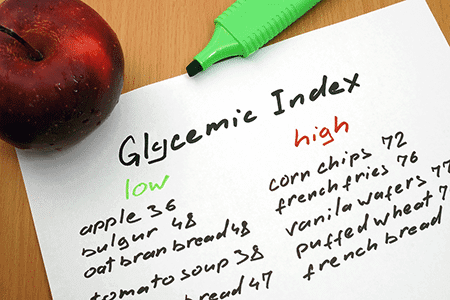Learning about the glycemic index may help people with diabetes better control their blood sugar levels. The glycemic index is a way to measure the effect certain foods have on your blood sugar. Controversy still remains when the glycemic index is discussed. Some professionals say eating foods with a high glycemic index in combination with other foods may not have a negative effect on blood sugars. Let’s find out more about the glycemic index. Always check with your physician when making any changes.
- Researchers continue to study what makes blood sugar levels soar in people with diabetes. Possible culprits include sugar, simple carbohydrates, complex carbohydrates, starches and more. The glycemic index is a way to try to gauge each food’s effect on your blood sugar. High glycemic foods tend to make blood sugar levels higher and increase your body fat as measured by the body mass index (BMI). Higher BMIs are linked to diabetes, heart disease and obesity. High glycemic foods include baked goods, packaged cookies and cakes, pasta, white bread, white rice, instant mashed potatoes and low-fiber cereals.
- Choosing low-glycemic foods may help you keep blood sugar levels in check. These foods include fresh vegetables and fruits such as broccoli and apples as well as whole grains such as bran cereal. Foods that are lower on the glycemic index are digested more slowly so you feel fuller longer. This can help you control your weight and metabolism.
- You should know that different carbohydrates land on the 1-100 Glycemic scale. Low GI carbohydrates are 55 and under while medium GI carbohydrates are 56 to 69. High GI carbohydrates are 70 and up. The GI ranks foods that contain carbohydrates. Make wise choices when it comes to other foods; try to select foods that are low in sugar, salt and fat.
- Research has shown that low-GI diets may help reduce “bad” LDL cholesterol and triglycerides. This type of diet can also boost “good” HDL cholesterol. Bad cholesterol can contribute toward blocked arteries, heart disease and stroke while good cholesterol helps prevent clogged arteries. Choose whole-grain pasta and breads. Eat baked goods made with sugar substitute rather than white sugar products. This can satisfy your craving for a sweet treat without making your blood sugar levels spike.
- Eating low-GI foods may improve lipid and glucose levels in people with type 1 and type 2 diabetes. Low GI-foods may help you lose weight by delaying hunger and controlling your appetite. Research has shown low-GI foods can reduce insulin levels and insulin resistance. The World Health Organization (WHO) and Food and Agricultural Organization (FAO) recommend low-GI foods to help prevent common diseases such as diabetes, obesity and coronary heart disease.
- Discuss a low GI meal plan with your health care team to see if it is the right choice for you. Read nutritional labels and remember to include the four food groups in your daily meals including fruit and veggies, whole grains, lean fish and meat and low-fat dairy items. Exercise for a least 30 minutes a day, 5 days a week to maintain optimum health.
Knowing more about the glycemic index can help you maintain proper blood sugar levels. Eating low GI foods can help you shed pounds and ward off disease. Work with your doctor or dietitian to develop a meal plan you can stick to and enjoy.







Leave A Comment